
Chapter 1
Starting a Mom Blog
In This Chapter
▶ Understanding what makes mom blogs different
▶ Exploring the range of opportunities you can develop with your blog
▶ Avoiding some of the easiest mistakes to make
▶ Getting to know some of the blog-writing basics
T
wo big questions I was frequently asked while I was writing this book
were: “Why a book just for mom bloggers? How is that different from
any other kind of blog?” These are actually fantastic questions — in fact, we
purposely named the book “Mom Blogging” rather than “Mommy Blogging”
because there are tens of thousands of moms who blog, but don’t happen
to make their family lives and motherhood a big part of the content of their
blogs. Mommy blogging is a genre — whereas mom blogging is for any mom
who blogs.
That being said, many moms who blog will find that they are treated like a
mommy blogger even when they don’t discuss mom-centric topics. I found
this particularly prominent when I ran my Sparkplugging business blog net-
work. I got pitched all the time to write about laundry detergent, diapers,
or kids’ snack foods — when my blog was only focused on Internet business
and entrepreneurship. Brands have long known that moms are high-impact
influencers, and that we control 85 percent of household spending in the
United States. We are also natural online socializers and word-of-mouth
marketers — 79 percent of moms are active on social networking sites, and
23 percent of these moms said they have purchased a children’s product as
a result of a recommendation from a social networking site or blog.
In fact, mom bloggers are more likely to be approached by a brand than
if they were just everyday bloggers — 33 percent of bloggers have been
approached by a brand, but 54 percent of mom bloggers have been
approached by a brand. As a mom blogger who has also worked in the cor-
porate marketing world, I can safely say that this high profile as a target of
marketers has been both a blessing and a curse for everyone involved. It has
empowered moms to transform their influence into rewarding careers as
publishers and marketers. Plus it has given brands unprecedented access to
directly engage their most important customers and get real-time feedback.
06_9781118038437-ch01.indd 906_9781118038437-ch01.indd 9 6/14/11 12:19 AM6/14/11 12:19 AM
COPYRIGHTED MATERIAL

10
Part I: Discovering the Fun and Advantages of Mom Blogging
A dark side has also emerged from both bloggers and brands. Some mom
bloggers have let their influence go to their heads, thinking they are suddenly
entitled to royal treatment — or (worse) using their blogs as extortion tools.
Brands have also taken advantage of mom bloggers who have less business
experience, exploiting all that eagerness as a way to get free (or extremely
cheap) advertising.
There you have two of the biggest reasons I wanted to write this book. I
wanted to give you the information and tools you need in order to turn your
blogs into real businesses or career opportunities. I get raving mad when I
see people whom I consider a part of my own online community getting taken
advantage of. But I also want the mom-blogging community and industry to
grow and change with the fast-paced changes in word-of-mouth marketing.
Acting entitled and using a blog as a weapon hurt both the blogger and the
reputation of mom bloggers as a whole. If you’re concerned about making
sure you get appropriately compensated for your time and your talent, I go
into this subject at length in Chapter 10, because I think we can all agree that
we don’t want to be taken advantage of!
What Makes Mom Blogs Different
From Other Blogs
It’s very difficult to make any blanket statements about moms who blog. But
most of the mom bloggers I know share some commonalities. Mom bloggers
are natural networkers and usually extremely helpful and supportive of each
other. Mom bloggers also turn to each other for advice — as I said earlier,
this is what makes mom bloggers so attractive to brands and advertisers:
Brands hope that when moms give advice on their blogs, they advise readers
to use the brand’s products or services.
Many mom bloggers talk about their personal lives in some way, even when
their blogs aren’t considered personal blogs. This is another big reason I
wanted to write this book. Mom bloggers — especially mommy bloggers who
write about parenting — are in a position to disclose highly personal subject
matter about themselves and their families. It is this personal, from the heart
writing that allows readers to so deeply connect with the blogger. But there
are things mom bloggers should all do in this day and age to ensure their
families are kept from embarrassment or worse, harassment, threats, and
personal attacks. (I cover this in more detail in Chapter 3.)
There are few, if any, bloggers who start out knowing exactly where their
blog will take them, myself included. I started blogging simply because I
heard blogs would help your website get found in the search engines. I had
no idea that blogging was such a powerful medium, that I would go on to
06_9781118038437-ch01.indd 1006_9781118038437-ch01.indd 10 6/14/11 12:19 AM6/14/11 12:19 AM

11
Chapter 1: Starting a Mom Blog
create two different blog networks, sell one of them, and then write a book
about it all. It sounds like I’m such a big deal when I put it that way, but
in reality, I still think of myself more like a newer blogger still learning the
ropes. In fact, when I decided to make blogging my business, I had to get over
my initial panic attack that I didn’t know the first thing about how to make
money from a blog. These are the lessons I’m most excited to share — my
highs and lows, my biggest mistakes, and how I finally created a blogging
business that worked for me as a mom, a writer, and an overly right-brained
entrepreneur with full-on attention deficit disorder.
Exploring the Opportunities
Blogging Can Offer
Most moms I know who have found success with their blogs started out
with a story similar to my own. They didn’t have any idea that their blogs
would take off, and they too wondered how the heck to turn their success
into an income that justified the time they spent. They also started out with
somewhat similar blogs, usually sharing posts on motherhood and family.
Interestingly, as they got more successful, the blogs became more and more
different from each other. They have turned their personal mom musings into
consulting firms, brand ambassadorships, blog networks, huge conference
events, online e-commerce stores, and even book and movie deals. I see mom
bloggers on the Today Show and in TV commercials, in national breast cancer
awareness campaigns and visiting the White House.
Keep in mind that the vast majority of mom bloggers earn a living not directly
from their blogs, but because of their blogs (I talk about this more specifically
in Chapter 4). Blogs are an extremely powerful way to build a platform for
your personal brand. A platform is a way of describing your circle of influence
online and in the media. It includes how many friends you have on social net-
working sites, how many people follow your blog, how many times you may
have been mentioned on other websites, in the news, or even on TV. Your per-
sonal brand is how you define and project an image of yourself, so that people
come to know you and what you stand for. You can probably guess the kind of
personal brand that’s behind a mom blogger who goes by a nickname such as
Rock and Roll Mama or A Cowboy’s Wife.
Bloggers with strong platforms and strong personal brands are the most
sought after personalities in the blogosphere. With these advantages, you
can attract the opportunities that suit your blogging business the most.
These may come in the form of sponsorship and advertising dollars, or (as
I mention earlier) book deals, speaking opportunities, and even job offers.
Your brand and your platform help you to do whatever you want to do.
06_9781118038437-ch01.indd 1106_9781118038437-ch01.indd 11 6/14/11 12:19 AM6/14/11 12:19 AM

12
Part I: Discovering the Fun and Advantages of Mom Blogging
But what if you don’t know what you want to do? In Chapter 4, I show you
how the five main blogging business models work — and what it takes to be
successful with each. You may find a business idea that will work for you, or
you may want to combine ideas to build a more customized business idea.
Then, in Chapter 18, I give you ten examples of mom bloggers who have
found success in ten very different ways. They serve as an inspiration to
all of us as we each find our own paths to success.
Deciding If Mom Blogging
Is Right for You
If you’re a mom who wants to blog and earn an income, then this book is for
you. Although this isn’t a book about personal blogging, you’ll find that many
of the most successful mom bloggers started out with very personal sites
that they never intended to become businesses. (Remember: A mom blog-
ger is different from a mommy blogger. A mom blogger is simply a mom who
blogs; a mommy blogger writes within a genre of blogs about parenting and
family life.)
The mom-blogging community is made up of such a wide range of blog topics
that the only thing we all have in common is motherhood. This includes
women who are contemplating motherhood (but aren’t there yet) or have
had the experience of motherhood changed by family tragedies. I’d even say
there are many dad bloggers who consider themselves a part of the mom-
blogging community. So if this is you and you want to blog, then mom blog-
ging is probably right for you. Here’s a practical distinction between mommy
blogging and mom blogging: How much of your motherhood and family life
do you want to share on your blog? Sometimes this issue verges on irrel-
evant; other bloggers talk about nothing else.
Deciding where to create your personal boundaries is extremely important
when you blog about other people in your family, especially children. There is
no one-size-fits-all answer, but Chapter 3 talks about the issues that affect your
decision on what and how much to share.
Telling your story
Blogs started out as personal online journals. While they have evolved
quite a lot since the early 2000s, it’s still true that the most successful blogs
are almost all written from a very personal point of view. Consumers can
get hard facts and news from hundreds of other sources. There is a true
hunger for content written in which the reader feels connected to the writer.
Personal stories and creations move blog readers.
06_9781118038437-ch01.indd 1206_9781118038437-ch01.indd 12 6/14/11 12:19 AM6/14/11 12:19 AM

13
Chapter 1: Starting a Mom Blog
This is even true on many business blogs. In the old-school way of thinking,
it wasn’t appropriate to talk about your children and marketing in the same
sentence. Today, more than half of all businesses are started from home. I’d
venture to say you can look for this number to soar when the new 2012 U.S.
business census data is released. As business life mixes more with home life,
it has become completely appropriate to share personal stories in a business
setting. In fact, out of the three years I spent blogging about business, every
single one of my most popular posts were ones in which I shared highly per-
sonal stories about my own entrepreneurial past.
Blogging about subjects you would normally only talk about with close friends
may come naturally for some writers. For most bloggers, it takes some time
to find a blogging voice — your personal style of writing that reflects who you
really are while also creating engaging content that others love to read.
You’ve probably heard this before, but the easiest way to start your blog and
tell your story is to write about what you are passionate about. When you
come from a place of such excitement and enthusiasm, even everyday stories
become engaging content that invokes sharing and discussion. (I talk a whole
bunch more about finding your voice and your passion in Chapter 3.)
Connecting with other moms
A mom new to blogging recently shared with me that she perceived the mom-
blog community as difficult to break into. I was admittedly surprised by her
assessment, because I think of the mom-blogging community as extremely
welcoming and supportive. But then I realized that I felt almost exactly the
same way she did when I started in 2006.
Being a new blogger is a little like trying to make connections in a room full of
people you have never met. And if you’ve ever been to a formal networking
event, you know how intimidating this can be. But the fact of the matter is
that most of the people in the room feel just as shy as you do. I put on a good
game face at these events, but inside, I hate having to introduce myself and
start multiple awkward conversations in the hopes I can find just one friend
who can help me get through the meeting. Actually, connecting with other
mom bloggers is far easier than this — at least you can do it in your jammies
with a cup of coffee next to the computer!
Introducing yourself and starting conversations via blogging is as simple as
writing posts on your blog, writing comments on others’ blogs, and linking to
the bloggers you hope to get to know better. This is exactly how all mom blog-
gers started, no matter how successful they are today. And frankly, these things
never lose their effectiveness. As you get more established, it may become
harder to stay on top of these kinds of connections. But even after 5+ years at
this, I still set aside time every few days to reconnect with my online friends,
find new bloggers, and link enthusiastically to as many bloggers as I can.
06_9781118038437-ch01.indd 1306_9781118038437-ch01.indd 13 6/14/11 12:19 AM6/14/11 12:19 AM

14
Part I: Discovering the Fun and Advantages of Mom Blogging
There are also more subtle ways to connect with other moms — just by shar-
ing your experiences in a way that resonates with your readers. You’ll find
that even though you can connect directly with readers through their com-
ments and through their own blogs, you will always have a group of readers
called lurkers. These are people who return to your blog regularly, but never
directly interact with you. You may not be able to get to know these readers,
but the fact that they feel connected to you through your writing is a power-
ful motivator to write more and be accountable to your audience. You can
find out a little more about lurkers through your blog analytics — and I talk
about that in Chapter 5.
Making a difference
Bloggers have always been great at using their blogs to support their favorite
causes. Fortunately, you don’t have to be a huge blogger to make a differ-
ence. It can be on a personal level, as you communicate one-on-one with one
of your readers, or you can use your platform of influence to raise awareness
for larger organizations or campaigns you support.
When I first started blogging, the fact that readers specifically said that some
of my entries had helped them in their own businesses or lives was really the
only reward I had for my blogging efforts. It was a powerful reward indeed,
and it kept me going when times and finances got tough. And even if all my
blogging efforts had failed on a business level, I knew in my heart that I had
been successful because of these conversations.
Yet some of the most poignant and powerful ways bloggers have made a
difference is by turning their own personal tragedies into the ability to help
others through difficult times. Mom blogger Heather Spohr lost her daugh-
ter Maddie suddenly to a respiratory infection when she was less than two
years old. Maddie had been born premature, and spent the first 68 days of
her life in the NICU (neonatal intensive care unit). After Maddie passed away,
Heather created Friends of Maddie (http://friendsofmaddie.org),
a not-for-profit organization that helps parents when their babies also get
admitted to the NICU. She’s also funneled her grief into action, using her blog-
ging and social media savvy to raise over $100,000 for the March of Dimes
foundation. You can see the good that Heather is doing with her blogging
experience on Friends of Maddie in Figure 1-1.
06_9781118038437-ch01.indd 1406_9781118038437-ch01.indd 14 6/14/11 12:19 AM6/14/11 12:19 AM

15
Chapter 1: Starting a Mom Blog
Figure 1-1:
Heather
Spohr
founded
Friends of
Maddie
after the
sudden
loss of her
toddler
daughter.
As your blog and your influence grow, you can also lend your voice to exist-
ing organizations for public awareness campaigns. Audrey McLelland, Sharon
Couto, and Jane Couto from MomGenerations write a fashion blog aimed at
moms, aunts, and grandmothers. Because of their success, The Estee Lauder
Companies approached them in the summer of 2010 to request that they
take part in the company’s ongoing Breast Cancer Awareness Campaign. The
three had no hesitation in throwing their support behind fighting a disease
that had taken their cousin, Cathy Holden, many years ago. While this meant
posing in a very revealing photo shoot, they consider it one of their biggest
accomplishments as bloggers and businesswomen.
Building a blogging business
When I first started blogging, everyone talked about how important the
people were who were on the A-List. I saw their success, wanted to be suc-
cessful too, and I vigorously pursued making a name for myself and getting
good publicity. When I started my first blog network, I consciously said to
myself, “If I could get national TV coverage like the Today Show, my site
would take off and get all the traffic it needs to be successful.” And indeed,
two years later, I was on the Today Show, talking about my website. My URL
went out to the world and the traffic came in. But within 72 hours, I was right
back where I had started. No lasting wave of traffic, my site did not become
06_9781118038437-ch01.indd 1506_9781118038437-ch01.indd 15 6/14/11 12:19 AM6/14/11 12:19 AM

16
Part I: Discovering the Fun and Advantages of Mom Blogging
a household name, and I realized how naïve I sounded when I first thought
that publicity was the key to my success. Even celebrities get forgotten the
instant they turn off the publicity machine.
Building an influential blog is quite different from building a successful busi-
ness. In fact, several moms who created incredibly well-known — and well-
loved — blogs later decided to take them down because their mom blogs
were interfering with their business goals. That’s why I dedicate Chapter 4
to finding a business model and making it work for your particular blog.
I know it seems like a worthy goal to become a well-known mom blogger. But
please don’t make the same mistake I did and confuse being well-known with
being able to make a living from blogging. In fact, hundreds of well-known
mom bloggers don’t earn as much as you may think. Your business model
always needs to come before self-promotion.
Developing an Influential
Online Presence
Influence is the ability to compel others to think or act in a new way. For a
professional blogger, being influential is very important. But there are differ-
ent ways that a blogger can be an influencer, and these ways range from very
general to very specific:
✓ Conversation starter
✓ Instigator
✓ Inspirer
✓ Educator
✓ Leader
✓ Marketer
✓ Community builder
✓ Entertainer
✓ Informer
Also, you don’t need to be an influential personality in order to be an influ-
encer. As is the case with my own blog network, Woo! Jr., many of our read-
ers don’t know who wrote a particular post; they just know the content is
engaging, useful, and relevant to their needs. For other kinds of blogs, it is
simply the voice of the writer that is influential. In Chapter 4, as I talk about
blogging business models, it will become clearer as to what kind of influence
will be most important for you to build. But for all kinds of bloggers, as your
influence grows, so will the number of opportunities that come to you.
06_9781118038437-ch01.indd 1606_9781118038437-ch01.indd 16 6/14/11 12:19 AM6/14/11 12:19 AM

17
Chapter 1: Starting a Mom Blog
The best way to increase your influence is to write what you love writing
about, not work on increasing your influence. There really isn’t some magical
way to get people to listen to you. Instead, you want to focus on adding value
and being a resource to your readers. Just as it is in life, the more you give,
the more you receive. I show you some really effective ways to do this in
Chapters 6 and 7. For the rest of this chapter, I talk about some of the basics
of blogging that apply to almost everyone.
Creating authenticity and integrity
The reason I wanted to cover authenticity and integrity in the very first
chapter is because they are the most important part of blogging. This is true
whether you’re blogging for personal or professional reasons. Every single
successful blog has been written by writers who have been true to them-
selves and to their readers. Readers don’t stay attracted to blogs that don’t
ring true and writers who aren’t genuine.
Writing authentically doesn’t mean writing perfectly. In fact, every successful
blog also has at least a few early blog posts that the bloggers are downright
embarrassed to admit they wrote. Authenticity simply means being honest
about your intentions and the information you are putting forward. But it
also means writing from the heart — whatever that means to you. I’m not
suggesting you need to be mushy-gushy, only that when you write and
represent who you really are, readers know it. And they love it.
In addition to this, the Federal Trade Commission (FTC) has put forth guide-
lines for bloggers that aim to ensure that any opinions expressed that have
been compensated by an advertiser must be disclosed in certain ways. The
Word of Mouth Marketing Association (WOMMA) has similar guidelines for
all marketers and writers involved in all forms of social media. These guide-
lines are critically important to maintain the integrity of the blogosphere and
all our long-term interests as bloggers. (I cover these guidelines in detail in
Chapter 9.)
Earning the trust of your readers is vital, no matter what business you
create with your blog. Readers who trust you are likelier to buy from you,
recommend you, or come back to your site. Some ways to earn that trust are
obvious — for example, telling the truth and being transparent in your words
and actions. More ways you can earn the trust of your readers sound a lot
like a mom’s good advice, because they are (and they work):
✓ Admit your faults and mistakes. It takes courage to be vulnerable to
others and it shows that you are human.
✓ Put your readers first. Always make sure that your readers’ best inter-
ests are served.
06_9781118038437-ch01.indd 1706_9781118038437-ch01.indd 17 6/14/11 12:19 AM6/14/11 12:19 AM

18
Part I: Discovering the Fun and Advantages of Mom Blogging
✓ Be inspiring. Knowing you have had your own struggles makes you
more real to your readers. Passing along that feeling of “I can do it”
is irresistible!
✓ Stick to your word. Make sure that you do everything you say you will
do, even in the smallest measure.
✓ Be consistent. People want to know what they can expect from you.
When you are inconsistent, it can lead readers to wonder what else
they don’t know about you.
✓ Give more than you expect to receive. Blogging is not the best platform
for a hard-sell approach, because of the social nature of the business.
Your fellow bloggers will respond to you best when you make adding
value a priority.
Building a community
Amusingly, just a few years ago, some people and companies thought that
social media was just a fad and would soon be gone. If you told that to the
more than 500 million Facebook users, I’m quite sure they would disagree.
Forrester estimates that by 2014, 3.1 billion dollars will be spent annually on
social media marketing campaigns (see http://soshable.com/wheres-
the-money-being-spent-in-social-media). The power of the Internet
to connect people and form communities is not going away.
In fact, 79 percent of moms with kids under 18 are active in social media, and
57 percent of Facebook users are women (see http://articles.sfgate.
com/2010-12-19/business/25209016_1_social-media-facebook-
page-twitter). Studies have proved that women lead the pack when it
comes to participating in online communities — it is very natural for women
to want to connect with other women.
Many of the most successful mom bloggers have created a sense of commu-
nity with their readers. Your community starts with the very first interactions
you have with your readers. As your readers interact with each other, your
community grows. They will let you know when what you write resonates
with them, and may not respond at all when you produce content they aren’t
interested in. They are absolutely a part of your blog and how it develops
over time. In fact, it was because of the community I built around my first
blog that I renamed the site — from eMoms at Home to Sparkplugging. My
community members included many dads, and they’d specifically told me
they thought the old name was off-putting. (Even the moms agreed, much to
my surprise.)
06_9781118038437-ch01.indd 1806_9781118038437-ch01.indd 18 6/14/11 12:19 AM6/14/11 12:19 AM

19
Chapter 1: Starting a Mom Blog
Blogs are natural community builders, but here are some more ways you can
foster the establishment of a thriving community around your blog:
✓ Encourage your readers to talk to each other. You need not be the only
source of information on your blog — your readers will love asking each
other for advice, inspiration, and information that you might not be able
to provide.
✓ Make your readers famous. This is some of the best advice that Darren
Rowse of ProBlogger has ever given. Link to your readers, invite them to
guest post and showcase their talents. You’ll be creating connections for
others and increasing your own reader loyalty at the same time.
✓ Be active in social media. Create a Facebook page so your readers can
connect with each other in their own social circles. Interacting with your
readers on Facebook and Twitter is important because you want to go to
where the conversations are already happening.
✓ Host regular linking events. You can do this by posting weekly links
to readers’ submissions, or you can use a linking tool like Linky Tools
(http://linkytools.com), which allows readers to create links them-
selves. This gets people coming back on a regular basis to get their con-
tent noticed and to meet new people.
✓ Respond to reader comments. While this is an extremely effective way
to get to know your readers, it can also quickly become time-consuming.
At some point, it can also become downright impossible. But to the
extent that you can respond to comments, it will always be highly appre-
ciated by those who take the time to comment on your blog posts.
Writing content readers love
If you are just starting out with a new blog, you might have no idea what
kind of content readers will love. You may write about things that you think
people will want to read, but the most important thing in blogging is to write
about what you are passionate about. This is true even if you think that
nobody will read your blog. When you write about what you absolutely love,
your excitement and enthusiasm for the subject are absolutely contagious.
I’m a true believer that each of us has a purpose in life, and our interests
and passions always lead us to that purpose. I’ve also learned to trust my
instincts. These are the two principles that guide most bloggers when they’re
first starting out. If you follow them, then as your blog starts to grow, you’ll
have more tools you can use to find out what readers love the most.
06_9781118038437-ch01.indd 1906_9781118038437-ch01.indd 19 6/14/11 12:19 AM6/14/11 12:19 AM

20
Part I: Discovering the Fun and Advantages of Mom Blogging
I encourage you to set up analytics software on your blog from Day 1. (I show
you how to do that in Chapter 5.) Your blog analytics will tell you exactly
how many people come to your site, how they found your blog, and which
posts are the most popular. Surprisingly, even when passion and instincts
are at work, sometimes the blog post you’re sure will be a big hit is a flop.
Other times, a post that you think will go nowhere becomes your most popu-
lar post ever. Only your analytics software can tell you these things — and
the longer you have this set up, the more information you’ll have that you
can use to your advantage.
06_9781118038437-ch01.indd 2006_9781118038437-ch01.indd 20 6/14/11 12:19 AM6/14/11 12:19 AM
-
 1
1
-
 2
2
-
 3
3
-
 4
4
-
 5
5
-
 6
6
-
 7
7
-
 8
8
-
 9
9
-
 10
10
-
 11
11
-
 12
12
Ask a question and I''ll find the answer in the document
Finding information in a document is now easier with AI
Related papers
-
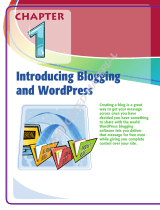 Wiley 978-0-470-57092-0 Datasheet
Wiley 978-0-470-57092-0 Datasheet
-
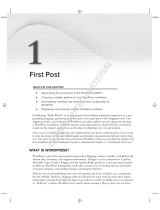 Wiley 978-0-470-56054-9 Datasheet
Wiley 978-0-470-56054-9 Datasheet
-
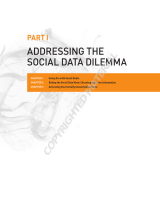 Wiley 978-0-470-93627-6 Datasheet
Wiley 978-0-470-93627-6 Datasheet
-
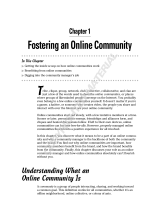 Wiley 978-1-1180-9917-9 Datasheet
Wiley 978-1-1180-9917-9 Datasheet
-
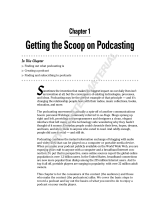 Wiley 978-0-470-27557-3 Datasheet
Wiley 978-0-470-27557-3 Datasheet
-
 Wiley 978-1-1180-2665-6 Datasheet
Wiley 978-1-1180-2665-6 Datasheet
-
 Wiley 978-1-1180-1412-7 Datasheet
Wiley 978-1-1180-1412-7 Datasheet
-
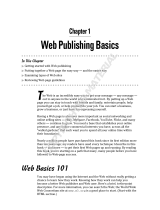 Wiley 978-0-470-38535-7 Datasheet
Wiley 978-0-470-38535-7 Datasheet
-
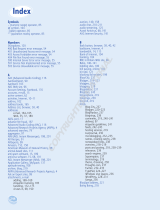 Wiley 978-0-470-40446-1 Datasheet
Wiley 978-0-470-40446-1 Datasheet
-
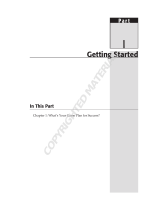 Wiley 978-0-470-64164-4 Datasheet
Wiley 978-0-470-64164-4 Datasheet
Other documents
-
Hasbro Baby Needs Me Operating instructions
-
Unbranded 207926 User guide
-
For Dummies 978-0-470-56556-8 Datasheet
-
Infantino 2-in-1 Bouncer & Activity Seat User manual
-
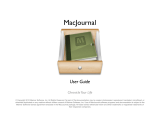 Mariner Software MacJournal 6.0, 1u, (NL / UK, DE, FR, IT, ES, JP) User guide
Mariner Software MacJournal 6.0, 1u, (NL / UK, DE, FR, IT, ES, JP) User guide
-
Sony 1206-2209 Datasheet
-
Apple MA362F/A Datasheet
-
Fujifilm Camcorder 3D W3 User manual
-
QVC E309722 User manual
-
Facebook Page Insights - 2011 User manual






















